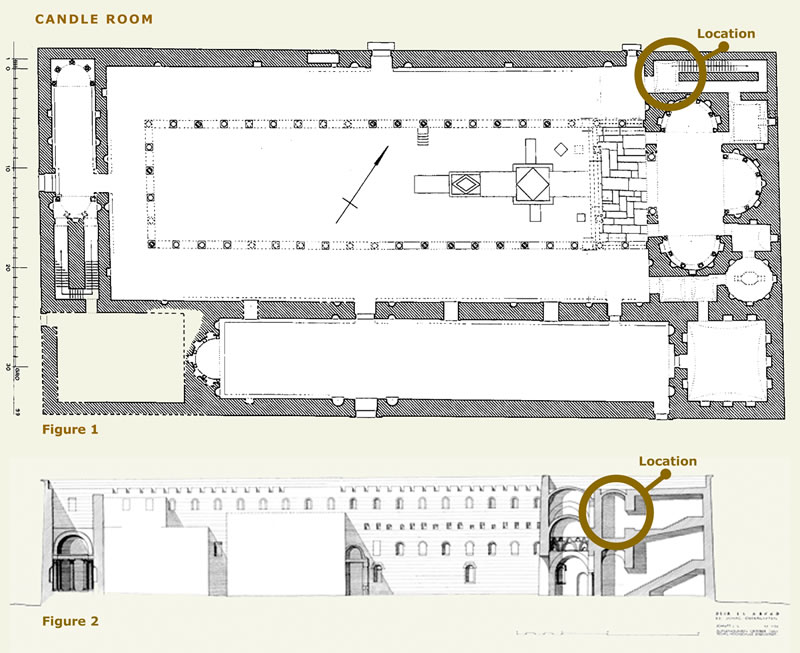Candle Room Manuscript Fragments
In December 2011, manuscript fragments were discovered in the course of excavations conducted in the “Candle Room” of the White Monastery Church.
This “Candle Room” is located in the northeast corner of the White Monastery Church (fig. 1) at the top of a second flight of stairs to the north of the sanctuary (fig. 2). Formerly used as a space to store candles, charcoal, and other supplies, it has since been converted into a chapel dedicated to the Archangel Michael.
The fragments were photographed in December 2012, and these photos are now on display in the galleries below. The Yale Monastic Archaeology Project South (YMAP-South) has made this photographic archive publicly available in the hopes of achieving two objectives: first, to allow scholars the opportunity to study the fragments; and second, to facilitate the identification of the original codices to which the fragments belong. For further details concerning the excavation and associated finds, see Stephen J. Davis, Gillian Pyke, Elizabeth Davidson, Mary Farag, and Daniel Schriever, with contributions by Louise Blanke, “Left Behind: A Recent Discovery of Manuscript Fragments in the White Monastery Church,” Journal of Coptic Studies 16 (2014), 69–87.

Figure 1. Peter Grossmann, “Christliche Architektur in Ägypten” (Handbook of Oriental Studies, Section One, The Near and Middle East, Volume 62, Leiden, Brill, 2002), fig. 150.
Figure 2. Architectural plans from Hans Gerhard Evers, Rolf Romero, and members of the Technische Hochschule Darmstadt, unpublished architectural drawings of the Church based on survey work conducted in October 1962. Long section looking north (Schnitt L-L), courtesy of Peter Grossmann.
The photo-gallery sites below feature 878 of the 1,336 fragments of parchment, paper, and leather and binding materials tfound in the Candle Room. The remaining fragments were blank pieces of parchment (300 in number) and paper (120 in number), as well as other written materials (38 in number) described at the bottom of this page. Photographs of these latter materials are not included here.

Figure 3. Floor loci in the Candle Room after excavation.
Of the ten galleries accessible below, the first six display parchment fragments; the next three, paper; and the last one, leather and binding materials. Each photograph contains two images of every fragment (one of each side, labeled “a” and “b”) accompanied by a one-centimeter scale and an identification number. The first four digits of the ID number refer to one of four excavation loci in the Candle Room: 1128, 1129, 1130, and 1131. Locus 1128 was a layer one-centimeter thick of dust covering the floor of the entire room. Locus 1129 is a large break in the plaster floor parallel to the north wall. Locus 1130 is a small break in the plaster floor in the southwest corner. Locus 1131 is a small break in the plaster floor in the western central part of the floor. See figure 3 for images of the room and its loci after excavation.
The Fragments
Note that the images in the archive are optimized for online use. Please contact stephen.davis@yale.edu for larger and/or higher resolution images.
Parchment
- The photographs of parchment fragments are divided among six galleries. The first three contain photographs of Coptic fragments; the fourth, Arabic; and the fifth and sixth, parchment fragments with too little ink present to identify the language of the script.
- Coptic 1128.3110 and 1131.3150 (24); 1129.3124 Set 1 (176) and 1129.3124 Set 2 (177)
- Arabic 1128.3110 and 1129.3124 (5)
- Unidentified 1128.3110 (69) and 1129.3124 (171)
Paper
- The photographs of paper fragments are divided among three galleries. The first contains photographs of Coptic fragments; the second, Arabic; and the third, paper fragments with too little ink present to identify the language of the script.
- Coptic 1128.3110; 1129.3124; 1129.3149; 1129.3121 and 1131.3117 (78)
- Arabic 1128.3110; 1128.3111; 1129.3149 and 1130.3121 (51)
- Unidentified 1128.3110; 1128.3111; 1129.3149 (102)
Leather and Binding Materials
- This gallery contains photographs of leather, possible cartonnage, and other binding materials.
- Leather and Binding Materials 1128.3112; 1129.3124 and 1129.3148 (25)
Other Written Materials
- In addition to these manuscript finds, the excavation also yielded three other kinds of written materials not on display here:
- Modern paper with printed text: twenty-nine (29) fragments primarily from Arabic newspapers, but also single fragments from a modern Greek newspaper, a modern French newspaper, and an Arabic schoolbook for children;
- Modern paper with handwritten text: seven (7) pieces of paper with Arabic petitions for remembrance, discernment, healing, reconciliation, blessing, and saintly intercession (four of these texts include requests directed to St. Shenoute the Archimandrite).
- A matchbox: two (2) fragments of a matchbox manufactured in Austria, one with an Egyptian Customs Administration notice.
